Roger Chouinard: The Q&A
Q: What are some of your favorite things about living and working in Southern California?
A: I was born there, and live in Topanga, which is a secluded canyon ten minutes from the beach where I love to explore. I have my studio and sculpture workshop at home. When I'm not working there I have a 30 minute drive to the animation studio I co-founded, DUCK Studios, in West Los Angeles, where I work on studio projects and benefit from being around very talented people. And of course, I love all the great artistic and cultural diversity and many great restaurants, art galleries, and museums that Los Angeles has to offer.
Q: Do you keep a sketchbook??
A: Yes, I do keep several sketchbooks: some for when I travel, and others for drawings made from squiggles and quick sketches of my wife at different restaurants. In the studio, I’ll sketch on loose sheets of paper that are lying around and then organize them in a scrapbook.
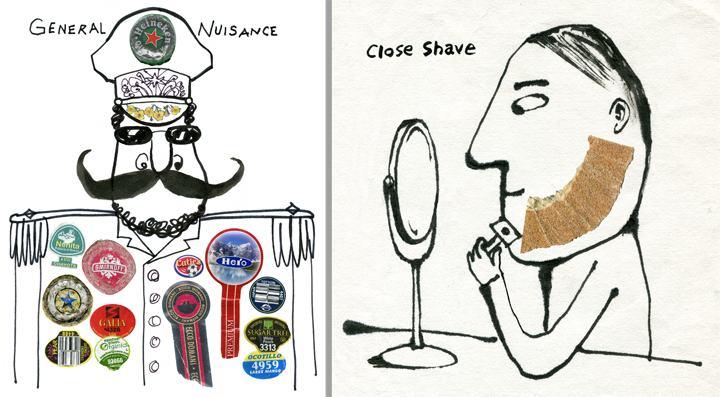
Q: What is the balance between the art you create on paper versus in the computer?
A: My work always starts on paper. I also use photos I take and things I scan as part of the process that I then combine and finish on the computer. The amount of computer work can vary depending on the job, anywhere from 25% to 75%.
Q: What do you like best about your workspace?
A: In my studio I'm surrounded by all my books, things I pick up and collect, a variety of artwork on the walls and with everything I need at my fingertips.
Q: Do you think it needs improvement, if so, what would you change?
A: My studio could always use more organization and space.
Q: What is the most important item in your studio?
A For my illustration work, it’s my computer. It’s how all of my art and effects layers are combined, touched up, color adjusted and finished. It’s also how I communicate during all stages of creating the assignment with the art director and sending the finished files.
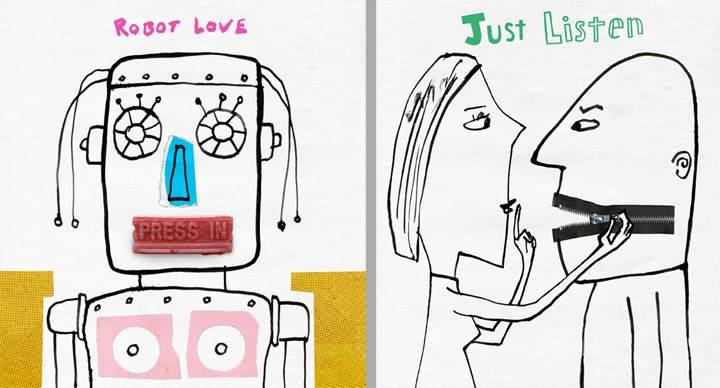
Q: What is your favorite part of the creative process?
A: There are two parts of the creative process I like best: the decision making and drawing in the beginning idea stage and then later when I get lost in the process of making the art and stop thinking about what I’m doing.
Q: What was the strangest or most unusual assignment you’ve taken? What made it a success or a failure?
A: I would say a job for a pharmaceutical client. It dealt with a medication for abdominal pain, hard stools, constipation and incomplete bowel movements, rather unpleasant and embarrassing ailments. The art director picked me because she wanted the artwork to have some visual humor with metaphor and playfulness. I used several images to illustrate the symptoms: a man whose body was a tightly crumpled bag, a woman’s bowels ties up in the shape of a balloon dog, and a big rubber band with “hard stools” and “constipation” written all over it, wrapped around a man’s lower stomach. The art director loved what I did but unfortunately, my work ended up not being used. Apparently, the client had a more literal and serious frame of mind.
Q: If you had to choose one medium to work in for an entire year, eliminating all others, what medium would you choose?
A: I’d probably pick sculpture. It allows me to work intuitively with my hands and use a variety of tools, which might be a band saw, welder, paintbrush or pocketknife. My sculptures usually start with a found object that I turn into an animal, robot, person or something non-representational. For some reason quite a few turn out to be birds. I never really know how they will evolve while I’m working on them, but that’s part of the fun.
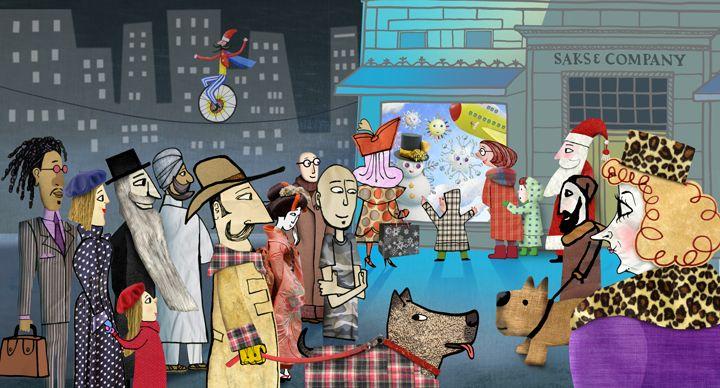
Q: What was your favorite book as a child?
A: The Walt Disney Donald Duck and Uncle Scrooge comic books written and illustrated by Carl Barks.
Q: What is the best book you’ve recently read?
A: I’d like to mention two: “Making Modernism” by Michael Fitzgerald, which tells how Picasso’s dealers help market him as the most famous artist of the 20th century and “The Future of the Brain” by Michio Kaku, which explores the amazing things we’re learning about the brain and all its capabilities.
Q: What was your first professional assignment and how did you get it?
A: My first professional assignment was a series of small posters for an Air Force Base talent contest. They came looking for an artist at the local newspaper art department where I was working at the time. I showed them my portfolio and got my first freelance job. The talent contest posters were very funny and effective.
Q: What did you learn from the experience?
A: From that experience I learned how nice it was to get paid for what you love doing, and the satisfaction of taking an assignment and coming up with concepts that hit the mark and communicated with entertaining humor.
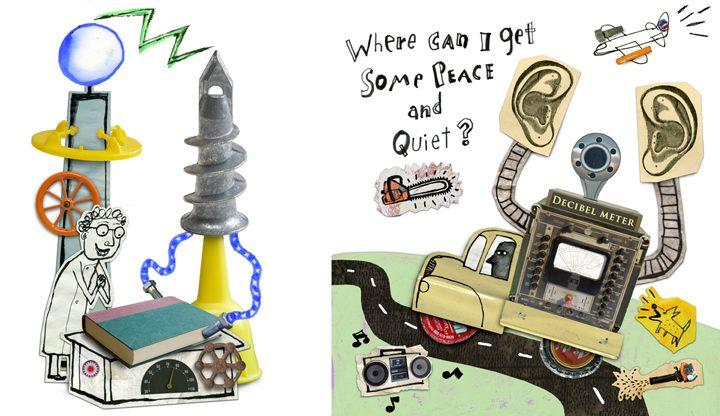
Q: What are some of your favorite places/books/blogs/websites for inspiration?
A: One of my favorite places to go is Japan. I go there every summer to enjoy the culture, the food, and to participate in an art camp for young children. I get inspiration from the art I see the children make; they can really surprise and amaze me with what they can do working with clay, wood, paint and found objects. I’m inspired by the Japanese sense of design in their packaging, signage, advertising, and character design. They mash up so many different influences in such an interesting visual way. I can get fascinated by the little ordinary things I see during my day, a piece of wood, rusted metal or beach debris that that looks interesting to me. I also get energized and inspired when I see other artists’ work in their studios or in museums and art galleries.
Q: What advice would you give a young artist about applying to an art school or college?
A: My advice would be to pick a school that has a diverse curriculum and doesn't lock you into one field. Be exposed to as many artistic and other experiences as possible to discover what your passion is.
Q: What are you working on now?
A: Right now I'm working on creating more animated short films based on found objects similar to the ones that were accepted in American Illustration 2014.
I’m also working on publishing a book I created, “PlayBook: Fun with Found Objects.”
Q: What is your hobby?
A: I like to collect all kinds of things, corks, chopstick wrappers, beach glass, old and new books, broken and old tools, toy robots and all kinds of old or rusted junk, which can end up in my work.
Q: If you could be anywhere but where you are now, where would that be?
A: If I could be anywhere other than where I am now, it would be beachcombing with my wife on a beautiful tropical island.
Q: What would be your last supper?
A: My last supper would be a Japanese meal with my wife and a perfectly chilled martini.
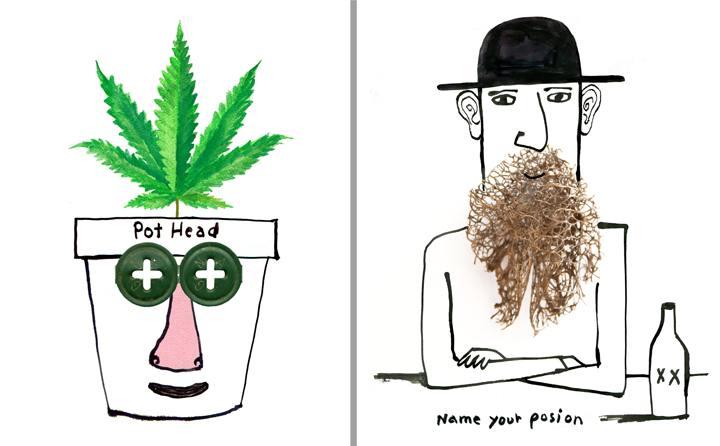
Roger Chouinard was born and grew up in Southern California. He studied design, drawing, painting and sculpture at Chouinard Art Institute, now called Cal Arts. He started his career working in a design studio and then various film studios as an art director and animation designer. Within a short time he soon decided to go out on his own and co-founded the award winning DUCK Studios animation company.
He has designed and directed numerous animated T.V. commercials and projects for a variety of clients including Levi's, 7Up, Nestle, Kellogg's, Verizon and the U.S. Olympic Committee. He has also written and illustrated two children's books for Doubleday: "Amazing Animal Alphabet" and "One Magic Box" and a Christmas book for Saks Fifth Avenue, "Twinkle Twinkle little Flake." His editorial illustrations have been in publications that include The New York Times, the Los Angeles Times, The Washington Post, The Boston Globe, Business Week, Forbes Magazine and The Wall Street Journal. His “Robot” collage paintings and sculptures have been exhibited in Los Angeles and Tokyo, Japan.
His awards include the N.Y. Art Director’s Gold Medal, the Communication Arts Award of Excellence, and several Clios. This year he was selected to be in both the 2014 Communication Arts and American Illustration annuals. Workbook. Rep.





